ECO mode CITROEN DS3 2018 Handbook (in English)
[x] Cancel search | Manufacturer: CITROEN, Model Year: 2018, Model line: DS3, Model: CITROEN DS3 2018Pages: 248, PDF Size: 8.79 MB
Page 120 of 248
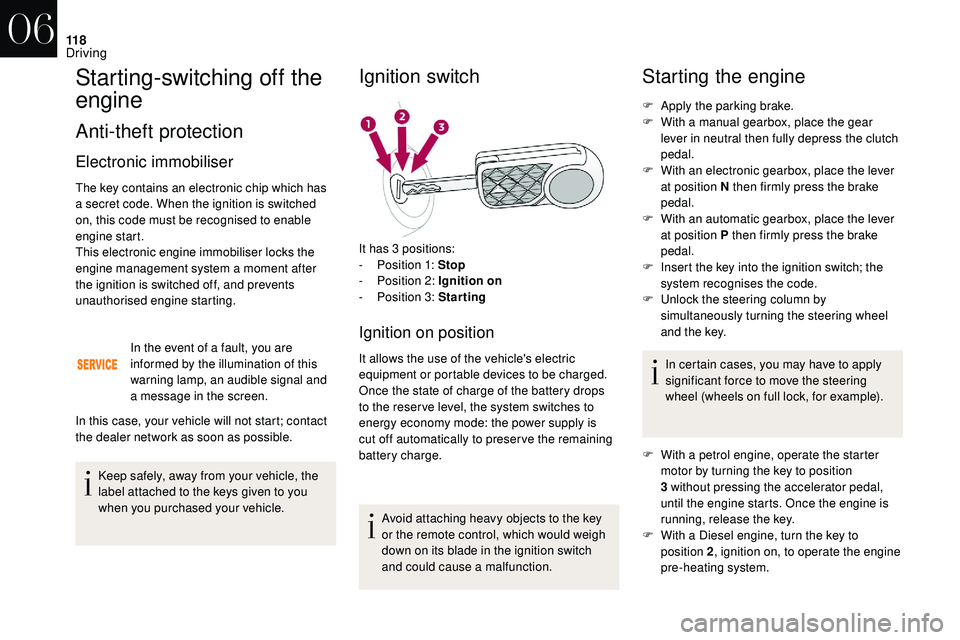
11 8
Starting-switching off the
engine
Anti-theft protection
Electronic immobiliser
The key contains an electronic chip which has
a secret code. When the ignition is switched
on, this code must be recognised to enable
engine start.
This electronic engine immobiliser locks the
engine management system a
moment after
the ignition is switched off, and prevents
unauthorised engine starting.
In the event of a
fault, you are
informed by the illumination of this
warning lamp, an audible signal and
a
message in the screen.
In this case, your vehicle will not start; contact
the dealer network as soon as possible.
Keep safely, away from your vehicle, the
label attached to the keys given to you
when you purchased your vehicle.
Ignition switch
Ignition on position
It allows the use of the vehicle's electric
equipment or portable devices to be charged.
Once the state of charge of the battery drops
to the reser ve level, the system switches to
energy economy mode: the power supply is
cut off automatically to preser ve the remaining
battery charge.
Avoid attaching heavy objects to the key
or the remote control, which would weigh
down on its blade in the ignition switch
and could cause a
malfunction.
Starting the engine
It has 3 positions:
- P osition 1: Stop
-
P
osition 2: Ignition on
-
P
osition 3: Starting F
A
pply the parking brake.
F
W
ith a manual gearbox, place the gear
lever in neutral then fully depress the clutch
pedal.
F
W
ith an electronic gearbox, place the lever
at position N then firmly press the brake
pedal.
F
W
ith an automatic gearbox, place the lever
at position P then firmly press the brake
pedal.
F
I
nsert the key into the ignition switch; the
system recognises the code.
F
U
nlock the steering column by
simultaneously turning the steering wheel
and the key.
In certain cases, you may have to apply
significant force to move the steering
wheel (wheels on full lock, for example).
F
W
ith a petrol engine, operate the starter
motor by turning the key to position
3
without pressing the accelerator pedal,
until the engine starts. Once the engine is
running, release the key.
F
W
ith a Diesel engine, turn the key to
position 2 , ignition on, to operate the engine
pre-heating system.
06
Driving
Page 121 of 248
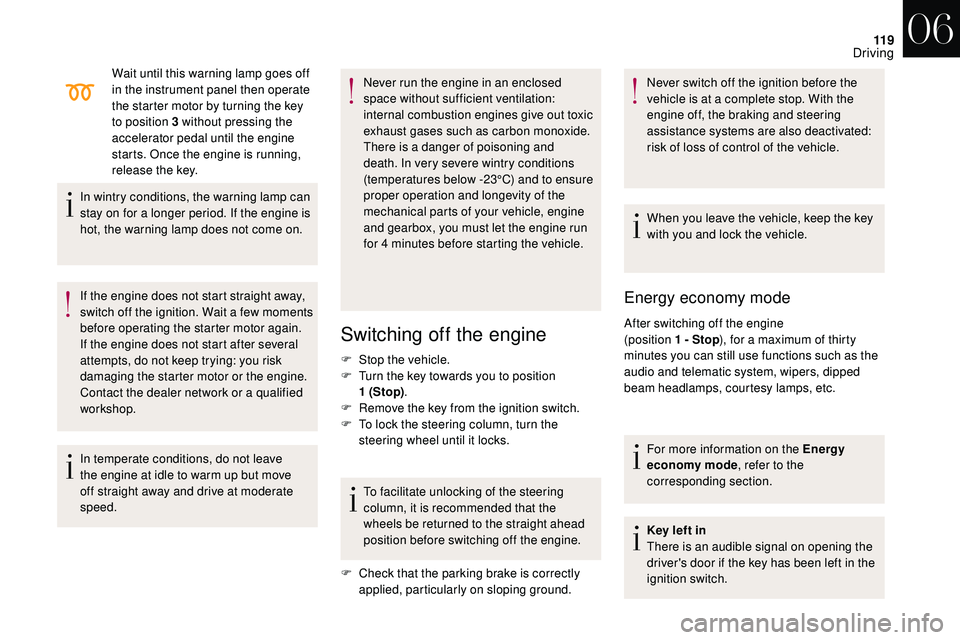
11 9
Wait until this warning lamp goes off
in the instrument panel then operate
the starter motor by turning the key
to position 3 without pressing the
accelerator pedal until the engine
starts. Once the engine is running,
release the key.
In wintry conditions, the warning lamp can
stay on for a
longer period. If the engine is
hot, the warning lamp does not come on.
If the engine does not start straight away,
switch off the ignition. Wait a
few moments
before operating the starter motor again.
If the engine does not start after several
attempts, do not keep trying: you risk
damaging the starter motor or the engine.
Contact the dealer network or a
qualified
workshop.
In temperate conditions, do not leave
the engine at idle to warm up but move
off straight away and drive at moderate
speed. Never run the engine in an enclosed
space without sufficient ventilation:
internal combustion engines give out toxic
exhaust gases such as carbon monoxide.
There is a danger of poisoning and
death. In very severe wintry conditions
(temperatures below -23°C) and to ensure
proper operation and longevity of the
mechanical parts of your vehicle, engine
and gearbox, you must let the engine run
for 4
minutes before starting the vehicle.
Switching off the engine
F Stop the vehicle.
F T urn the key towards you to position
1
(Stop) .
F
R
emove the key from the ignition switch.
F
T
o lock the steering column, turn the
steering wheel until it locks.
To facilitate unlocking of the steering
column, it is recommended that the
wheels be returned to the straight ahead
position before switching off the engine.
F
C
heck that the parking brake is correctly
applied, particularly on sloping ground. Never switch off the ignition before the
vehicle is at a
complete stop. With the
engine off, the braking and steering
assistance systems are also deactivated:
risk of loss of control of the vehicle.
When you leave the vehicle, keep the key
with you and lock the vehicle.
Energy economy mode
After switching off the engine
(position 1 - Stop), for a
maximum of thirty
minutes you can still use functions such as the
audio and telematic system, wipers, dipped
beam headlamps, courtesy lamps, etc.
For more information on the Energy
economy mode , refer to the
corresponding section.
Key left in
There is an audible signal on opening the
driver's door if the key has been left in the
ignition switch.
06
Driving
Page 126 of 248
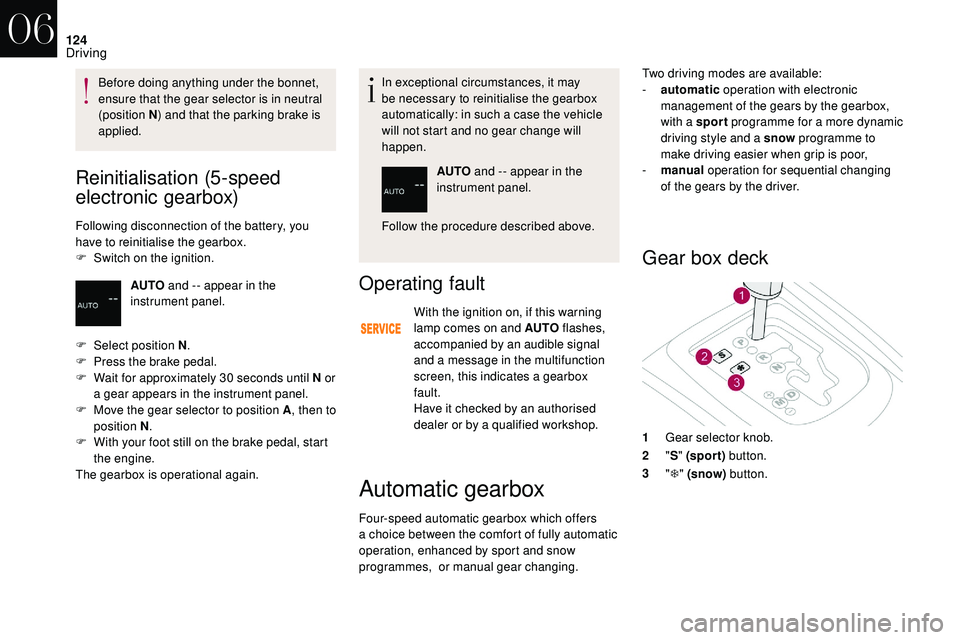
124
Reinitialisation (5-speed
electronic gearbox)
Following disconnection of the battery, you
have to reinitialise the gearbox.
F
S
witch on the ignition. In exceptional circumstances, it may
be necessary to reinitialise the gearbox
automatically: in such a
case the vehicle
will not start and no gear change will
happen.
Operating fault
With the ignition on, if this warning
lamp comes on and AUTO flashes,
accompanied by an audible signal
and a
message in the multifunction
screen, this indicates a
gearbox
fault.
Have it checked by an authorised
dealer or by a
qualified workshop.
AUTO
and - - appear in the
instrument panel.
F
Sel
ect position N .
F
P
ress the brake pedal.
F
W
ait for approximately 30
seconds until N or
a
gear appears in the instrument panel.
F
M
ove the gear selector to position A , then to
position N .
F
W
ith your foot still on the brake pedal, start
the engine.
The gearbox is operational again. AUTO
and - - appear in the
instrument panel.
Follow the procedure described above.
Automatic gearbox
Four-speed automatic gearbox which offers
a choice between the comfort of fully automatic
operation, enhanced by sport and snow
programmes, or manual gear changing. Two driving modes are available:
-
a
utomatic
operation with electronic
management of the gears by the gearbox,
with a sport
programme for a more dynamic
driving style and a snow
programme to
make driving easier when grip is poor,
-
man
ual
operation for sequential changing
of the gears by the driver.
Gear box deck
1 Gear selector knob.
2 "S " (spor t) button.
3 "T " (snow) button.
Before doing anything under the bonnet,
ensure that the gear selector is in neutral
(position N
) and that the parking brake is
applied.
06
Driving
Page 129 of 248
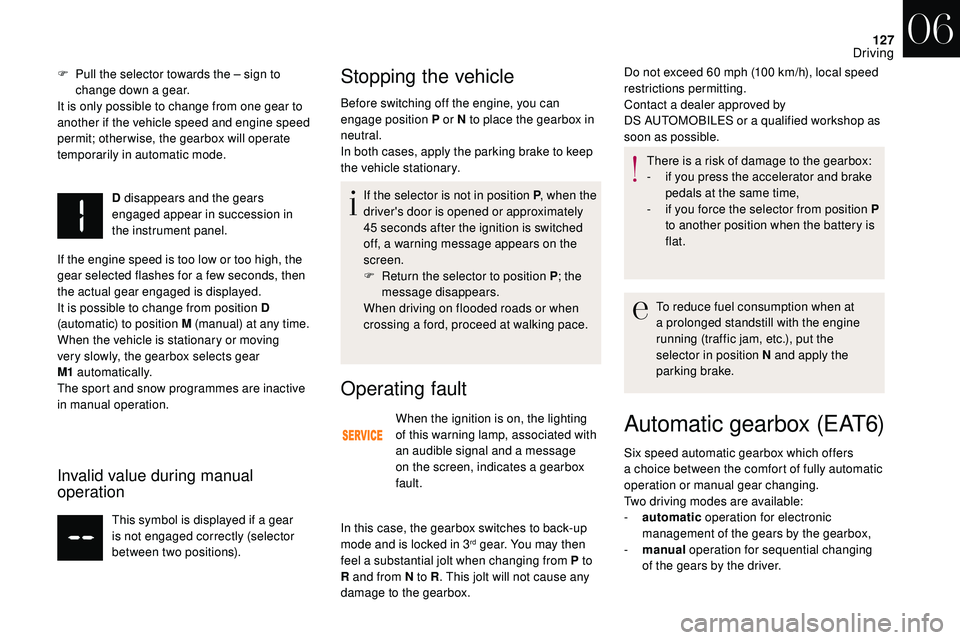
127
F Pull the selector towards the – sign to change down a gear.
It is only possible to change from one gear to
another if the vehicle speed and engine speed
permit; otherwise, the gearbox will operate
temporarily in automatic mode.
Invalid value during manual
operation
This symbol is displayed if a gear
i s not engaged correctly (selector
between two positions).
Stopping the vehicle
Before switching off the engine, you can
engage position P or N to place the gearbox in
neutral.
In both cases, apply the parking brake to keep
the vehicle stationary.
If the selector is not in position P , when the
driver's door is opened or approximately
45
seconds after the ignition is switched
off, a warning message appears on the
screen.
F
R
eturn the selector to position P ; the
message disappears.
When driving on flooded roads or when
crossing a
ford, proceed at walking pace.
Operating fault
D disappears and the gears
engaged appear in succession in
the instrument panel.
If the engine speed is too low or too high, the
gear selected flashes for a
few seconds, then
the actual gear engaged is displayed.
It is possible to change from position D
(automatic) to position M (manual) at any time.
When the vehicle is stationary or moving
very slowly, the gearbox selects gear
M1
automatically.
The sport and snow programmes are inactive
in manual operation. When the ignition is on, the lighting
of this warning lamp, associated with
an audible signal and a
message
on the screen, indicates a
gearbox
fault.
In this case, the gearbox switches to back-up
mode and is locked in 3
rd gear. You may then
feel a
substantial jolt when changing from P to
R and from N to R . This jolt will not cause any
damage to the gearbox. Do not exceed 60
mph (100 km/h), local speed
restrictions permitting.
Contact a dealer approved by
DS AUTOMOBILES or a qualified workshop as
soon as possible.
There is a risk of damage to the gearbox:
-
i
f you press the accelerator and brake
pedals at the same time,
-
i
f you force the selector from position P
to another position when the battery is
flat.
To reduce fuel consumption when at
a prolonged standstill with the engine
running (traffic jam, etc.), put the
selector in position N and apply the
parking brake.
Automatic gearbox (EAT6)
Six speed automatic gearbox which offers
a choice between the comfort of fully automatic
operation or manual gear changing.
Two driving modes are available:
-
a
utomatic operation for electronic
management of the gears by the gearbox,
-
man
ual operation for sequential changing
of the gears by the driver.
06
Driving
Page 132 of 248

130
D disappears and the gears
engaged appear in succession in
the instrument panel.
If the engine speed is too low or too high, the
gear selected flashes for a
few seconds, then
the actual gear engaged is displayed.
It is possible to change from position D
(automatic) to position M (manual) at any time.
When the vehicle is stationary or moving
very slowly, the gearbox engages first gear
automatically.
Invalid value during manual
operation
This symbol is displayed if a gear
i s not engaged correctly (selector
between two positions).
Stopping the vehicle Operating fault
When the ignition is on, the lighting
of this warning lamp, associated with
an audible signal and a
message
on the screen, indicates a
gearbox
fault. There is a
risk of damage to the gearbox:
-
i
f you press the accelerator and brake
pedals at the same time,
-
i
f you force the selector from position P
to another position when the battery is
flat.
Before switching off the engine, you can engage
either position P or N to place the gearbox in neutral.
In both cases, apply the parking brake to immobilise
the vehicle.
If the selector is not in position P , when the
driver's door is opened or approximately
45
seconds after the ignition is switched
off, a warning message appears in the
screen.
F
R
eturn the selector to position P ; the
message disappears.
When driving on flooded roads or when
crossing a
ford, proceed at walking pace. To reduce fuel consumption when at
a
prolonged standstill with the engine
running (traffic jam, etc.), put the
selector in position N and apply the
parking brake.
Gear efficiency indicator
System which reduces fuel consumption by
advising the driver when to change up.
Operation
Depending on the driving situation and your
vehicle's equipment, the system may advise
you to skip one (or more) gear(s). You can
follow this instruction without engaging the
intermediate gears.
It is only possible to change from one gear to
another if the vehicle speed and engine speed
permit; otherwise, the gearbox will operate
temporarily in automatic mode.
In this case, the gearbox switches to back-up
mode and is locked in 3
rd gear. You may then
feel a
substantial jolt when changing from P to
R and from N to R . This jolt will not cause any
damage to the gearbox.
Do not exceed 60
mph (100 km/h), local speed
restrictions permitting.
Contact the dealer network or a
qualified
workshop as soon as possible.
06
Driving
Page 133 of 248
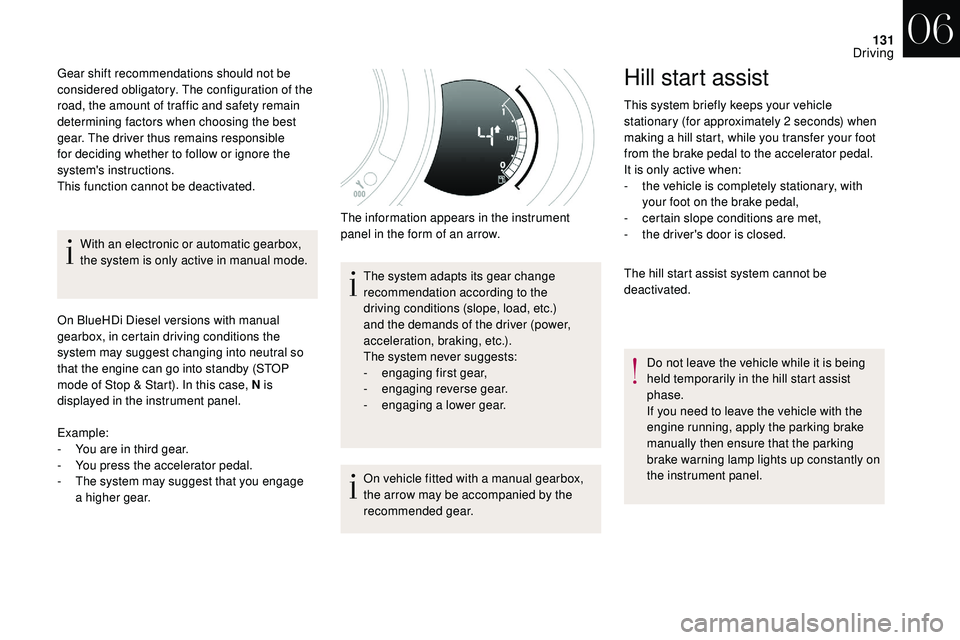
131
With an electronic or automatic gearbox,
the system is only active in manual mode.
On BlueHDi Diesel versions with manual
gearbox, in certain driving conditions the
system may suggest changing into neutral so
that the engine can go into standby (STOP
mode of Stop & Start). In this case, N is
displayed in the instrument panel.
Example:
-
Y
ou are in third gear.
-
Y
ou press the accelerator pedal.
-
T
he system may suggest that you engage
a
higher gear. The system adapts its gear change
recommendation according to the
driving conditions (slope, load, etc.)
and the demands of the driver (power,
acceleration, braking, etc.).
The system never suggests:
-
e
ngaging first gear,
-
enga
ging reverse gear.
-
enga
ging a
lower gear.
On vehicle fitted with a
manual gearbox,
the arrow may be accompanied by the
recommended gear.
Gear shift recommendations should not be
considered obligatory. The configuration of the
road, the amount of traffic and safety remain
determining factors when choosing the best
gear. The driver thus remains responsible
for deciding whether to follow or ignore the
system's instructions.
This function cannot be deactivated.
The information appears in the instrument
panel in the form of an arrow.
Hill start assist
This system briefly keeps your vehicle
stationary (for approximately 2 seconds) when
making a
hill start, while you transfer your foot
from the brake pedal to the accelerator pedal.
It is only active when:
-
t
he vehicle is completely stationary, with
your foot on the brake pedal,
-
c
ertain slope conditions are met,
-
t
he driver's door is closed.
The hill start assist system cannot be
deactivated.
Do not leave the vehicle while it is being
held temporarily in the hill start assist
phase.
If you need to leave the vehicle with the
engine running, apply the parking brake
manually then ensure that the parking
brake warning lamp lights up constantly on
the instrument panel.
06
Driving
Page 134 of 248
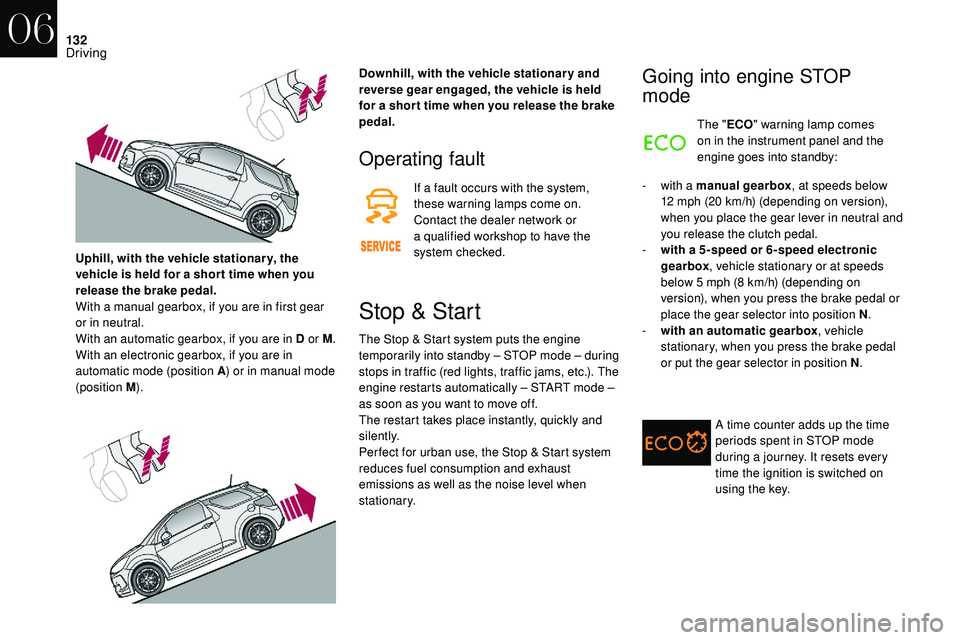
132
Operating fault
If a fault occurs with the system,
t hese warning lamps come on.
Contact the dealer network or
a
qualified workshop to have the
system checked.
Stop & Start
The Stop & Start system puts the engine
temporarily into standby – STOP mode – during
stops in traffic (red lights, traffic jams, etc.). The
engine restarts automatically – START mode –
as soon as you want to move off.
The restart takes place instantly, quickly and
silently.
Per fect for urban use, the Stop & Start system
reduces fuel consumption and exhaust
emissions as well as the noise level when
stationary.
Going into engine STOP
mode
The " ECO" warning lamp comes
on in the instrument panel and the
engine goes into standby:
-
w
ith a
manual gearbox , at speeds below
12
mph (20 km/h) (depending on version),
when you place the gear lever in neutral and
you release the clutch pedal.
-
w
ith a
5-speed or 6-speed electronic
gearbox , vehicle stationary or at speeds
below 5
mph (8 km/h) (depending on
version), when you press the brake pedal or
place the gear selector into position N .
-
w
ith an automatic gearbox , vehicle
stationary, when you press the brake pedal
or put the gear selector in position N .
A time counter adds up the time
periods spent in STOP mode
during a
journey. It resets every
time the ignition is switched on
using the key.
Uphill, with the vehicle stationar y, the
vehicle is held for a shor t time when you
release the brake pedal.
With a
manual gearbox, if you are in first gear
or in neutral.
With an automatic gearbox, if you are in D or M .
With an electronic gearbox, if you are in
automatic mode (position A ) or in manual mode
(position M ). Downhill, with the vehicle stationary and
reverse gear engaged, the vehicle is held
for a
shor t time when you release the brake
pedal.
06
Driving
Page 135 of 248
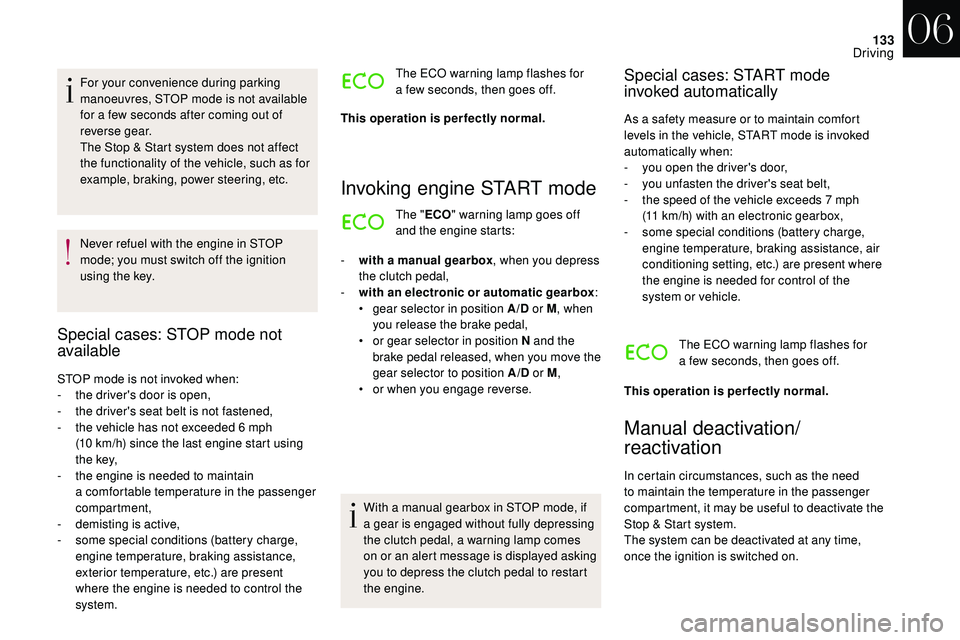
133
For your convenience during parking
manoeuvres, STOP mode is not available
for a few seconds after coming out of
reverse gear.
The Stop & Start system does not affect
the functionality of the vehicle, such as for
example, braking, power steering, etc.
Never refuel with the engine in STOP
mode; you must switch off the ignition
using the key.
Special cases: STOP mode not
available
STOP mode is not invoked when:
- t he driver's door is open,
-
t
he driver's seat belt is not fastened,
-
t
he vehicle has not exceeded 6 mph
(10
km/h) since the last engine start using
t h e key,
-
t
he engine is needed to maintain
a
comfortable temperature in the passenger
compartment,
-
d
emisting is active,
-
s
ome special conditions (battery charge,
engine temperature, braking assistance,
exterior temperature, etc.) are present
where the engine is needed to control the
system. The ECO warning lamp flashes for
a
few seconds, then goes off.
This operation is perfectly normal.
Invoking engine START mode
The " ECO" warning lamp goes off
and the engine starts:
-
w
ith a
manual gearbox , when you depress
the clutch pedal,
-
w
ith an electronic or automatic gearbox :
•
g
ear selector in position A/D or M, when
you release the brake pedal,
•
o
r gear selector in position N and the
brake pedal released, when you move the
gear selector to position A/D or M,
•
o
r when you engage reverse.
With a
manual gearbox in STOP mode, if
a
gear is engaged without fully depressing
the clutch pedal, a warning lamp comes
on or an alert message is displayed asking
you to depress the clutch pedal to restart
the engine.
Special cases: START mode
invoked automatically
As a safety measure or to maintain comfort
l evels in the vehicle, START mode is invoked
automatically when:
-
y
ou open the driver's door,
-
y
ou unfasten the driver's seat belt,
-
t
he speed of the vehicle exceeds 7 mph
(11
km/h) with an electronic gearbox,
-
s
ome special conditions (battery charge,
engine temperature, braking assistance, air
conditioning setting, etc.) are present where
the engine is needed for control of the
system or vehicle.
The ECO warning lamp flashes for
a
few seconds, then goes off.
This operation is perfectly normal.
Manual deactivation/
reactivation
In certain circumstances, such as the need
to maintain the temperature in the passenger
compartment, it may be useful to deactivate the
Stop & Start system.
The system can be deactivated at any time,
once the ignition is switched on.
06
Driving
Page 136 of 248
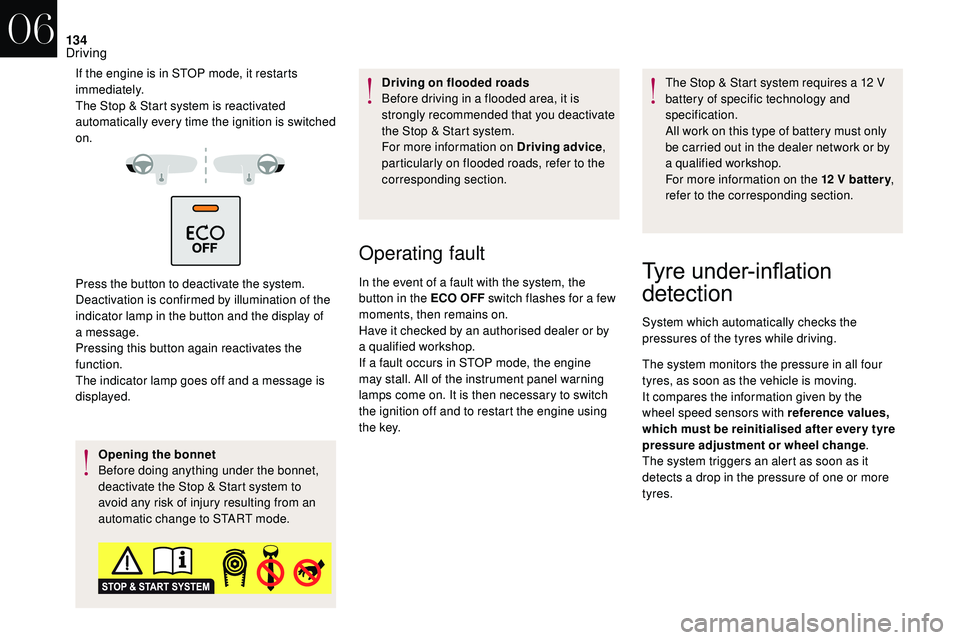
134
If the engine is in STOP mode, it restarts
immediately.
The Stop & Start system is reactivated
automatically every time the ignition is switched
on.
Press the button to deactivate the system.
Deactivation is confirmed by illumination of the
indicator lamp in the button and the display of
a
message.
Pressing this button again reactivates the
function.
The indicator lamp goes off and a
message is
displayed.
Opening the bonnet
Before doing anything under the bonnet,
deactivate the Stop & Start system to
avoid any risk of injury resulting from an
automatic change to START mode. Driving on flooded roads
Before driving in a
flooded area, it is
strongly recommended that you deactivate
the Stop & Start system.
For more information on Driving advice ,
particularly on flooded roads, refer to the
corresponding section.
Operating fault
In the event of a fault with the system, the
b utton in the ECO OFF switch flashes for a few
moments, then remains on.
Have it checked by an authorised dealer or by
a
qualified workshop.
If a
fault occurs in STOP mode, the engine
may stall. All of the instrument panel warning
lamps come on. It is then necessary to switch
the ignition off and to restart the engine using
t h e key. The Stop & Start system requires a
12 V
battery of specific technology and
specification.
All work on this type of battery must only
be carried out in the dealer network or by
a
qualified workshop.
For more information on the 12 V batter y
,
refer to the corresponding section.Tyre under-inflation
d
etection
System which automatically checks the
pressures of the tyres while driving.
The system monitors the pressure in all four
tyres, as soon as the vehicle is moving.
It compares the information given by the
wheel speed sensors with reference values,
which must be reinitialised after ever y tyre
pressure adjustment or wheel change .
The system triggers an alert as soon as it
detects a
drop in the pressure of one or more
tyres.
06
Driving
Page 137 of 248
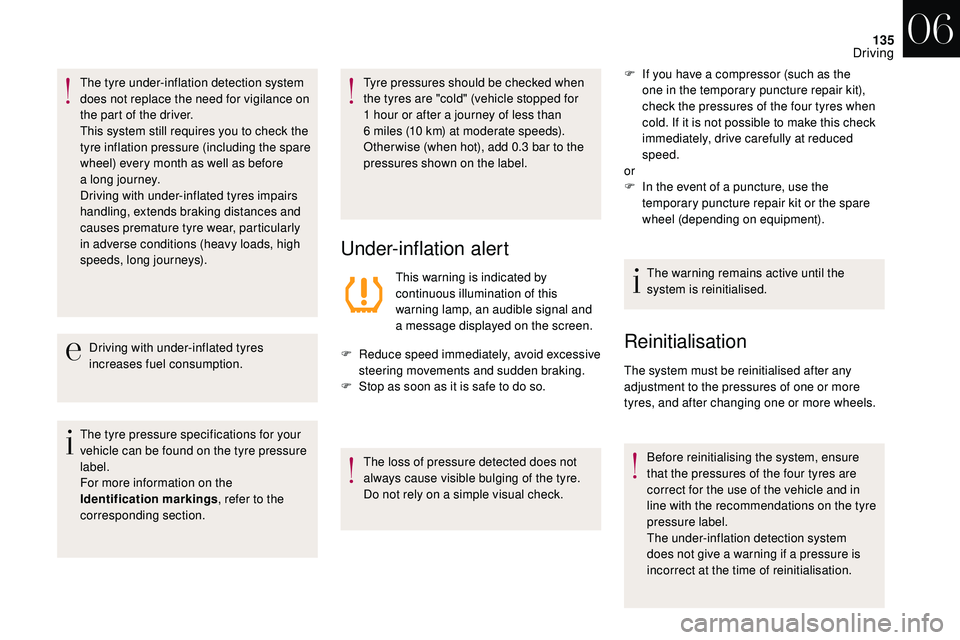
135
The tyre under-inflation detection system
does not replace the need for vigilance on
the part of the driver.
This system still requires you to check the
tyre inflation pressure (including the spare
wheel) every month as well as before
a
long journey.
Driving with under-inflated tyres impairs
handling, extends braking distances and
causes premature tyre wear, particularly
in adverse conditions (heavy loads, high
speeds, long journeys).
Driving with under-inflated tyres
increases fuel consumption.
The tyre pressure specifications for your
vehicle can be found on the tyre pressure
label.
For more information on the
Identification markings , refer to the
corresponding section. Tyre pressures should be checked when
the tyres are "cold" (vehicle stopped for
1
hour or after a journey of less than
6
miles (10 km) at moderate speeds).
Other wise (when hot), add 0.3
bar to the
pressures shown on the label.
Under-inflation alert
This warning is indicated by
continuous illumination of this
warning lamp, an audible signal and
a
message displayed on the screen.
F
R
educe speed immediately, avoid excessive
steering movements and sudden braking.
F
S
top as soon as it is safe to do so.
The loss of pressure detected does not
always cause visible bulging of the tyre.
Do not rely on a
simple visual check. F
I
f you have a compressor (such as the
one in the temporary puncture repair kit),
check the pressures of the four tyres when
cold. If it is not possible to make this check
immediately, drive carefully at reduced
speed.
or
F In the event of a puncture, use the
temporary puncture repair kit or the spare
wheel (depending on equipment).
The warning remains active until the
system is reinitialised.
Reinitialisation
The system must be reinitialised after any
adjustment to the pressures of one or more
tyres, and after changing one or more wheels.
Before reinitialising the system, ensure
that the pressures of the four tyres are
correct for the use of the vehicle and in
line with the recommendations on the tyre
pressure label.
The under-inflation detection system
does not give a
warning if a pressure is
incorrect at the time of reinitialisation.
06
Driving